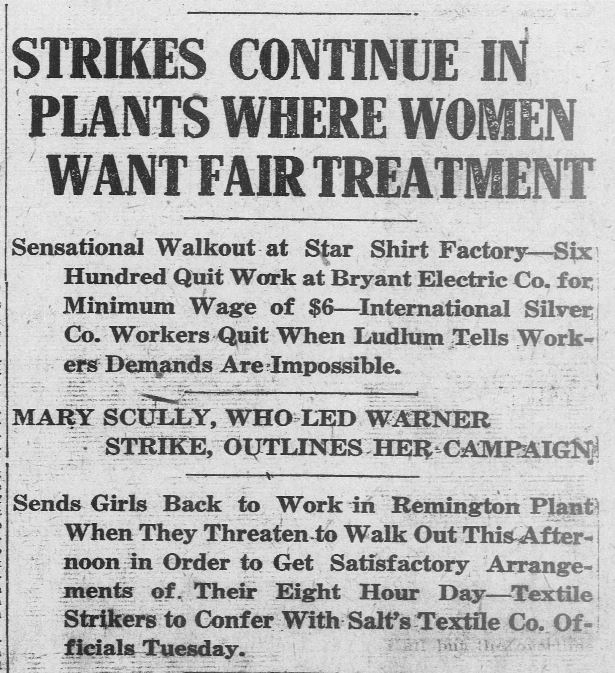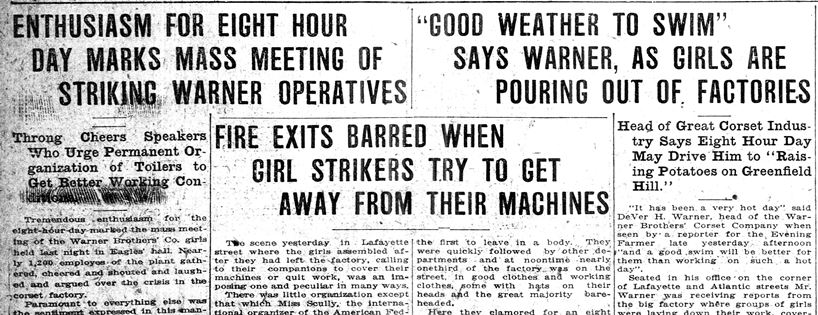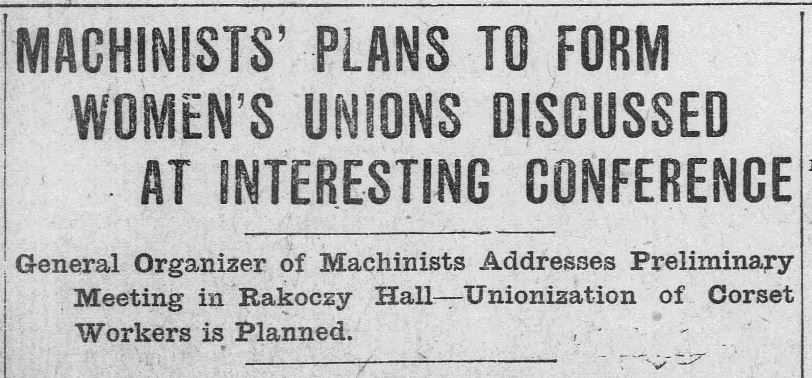Christine Gauvreau, Project Coordinator, Connecticut Digital Newspaper Project
Connecticut State Library
TEACHER'S SNAPSHOT
Subjects:
Business & Industry, Immigrants, Labor, Progressive Era, Women
Course Topics/Big Ideas:
Economic Prosperity and Equity
Town:
Bridgeport, Statewide
Grade:
High School
Lesson Plan Notes
In the summer of 1915, immigrant workers in Bridgeport, Connecticut, took advantage of the wartime boom and went on strike to demand an eight-hour work day, better wages, and improved working conditions. Skilled craftsmen led the strike, but when 11,000 less-skilled workers (many of them young women) joined the movement, it turned into a city-wide general strike.
ESSENTIAL QUESTION
SUPPORTING QUESTIONS
- What did the editors of the Norwich Bulletin suspect about the roots of the 1915 Bridgeport strikes?
- What picture do the articles from the Bridgeport Evening Farmer paint about the origin of the 1915 Bridgeport strikes?
- How did the U.S. Commission on Industrial Relations explain labor unrest to Congress in its 1914 report?
ACTIVITY
1. Break the students into four groups and assign a different resource or resource set to each:
Group 1: “The Bridgeport Situation,” Norwich Bulletin, July 20, 1915, and “Machinists’ Plan to Form Women’s Unions Discussed at Interesting Conference,” Bridgeport Evening Farmer, July 21, 1915.
Group 2: “26,000 Women Workers Will Have Better Conditions in Bridgeport,” Bridgeport Evening Farmer, August 20, 1915.
Group 3: “Enthusiasm Marks Mass Meeting of Striking Warner Operatives,” Bridgeport Evening Farmer, August 17, 1915. (Note: there are other related articles of interest on the same page which can be considered as well, as time allows.)
Group 4: “Low Wages and Desire for Better Living Conditions Causes of Labor Unrest: Industrial Committee Cites Reasons of Employers and Employees in Report to Congress,” Bridgeport Evening Farmer, December 8, 1914.
2. Have students list the reasons (as suggested by the different primary sources provided) for the August 1915 Bridgeport strike wave. Questions to explore might include:
- What industries were involved? What type of work did the laborers do?
- What were the workers’ concerns and demands?
- What were the concerns of management?
- What, if any, outside influences were there?
3. Students should then list the questions that each source and argument provokes. Have the students consider what additional sources they might seek to answer those questions.
4. Ask the students to suggest reasons why the different sources might offer divergent explanations for the Bridgeport situation.
5. Ask the students, after considering the various points of view provided, to develop a working hypothesis about the cause of Bridgeport’s labor unrest that could guide a more in-depth research project. For additional information and opinions about labor unrest in 1915, students can use the Chronicling America database of historic newspapers.
OPPORTUNITIES FOR ASSESSMENT
- Students will be divided into two groups—one representing labor and the other management in 1915. Develop arguments based on the newspaper sources (plus additional primary and secondary sources you may have used in the classroom) and hold a debate on the issues of labor conditions, wages, and the length of the work day/week.
- Students will use what they have learned from the newspaper accounts (and any other resources on the topic you have used in the classroom) to create their own picket signs for workers striking in 1915 Connecticut.
- Students will use newspapers, the internet, and other sources to investigate labor issues in Connecticut today, including the campaign for a $15 minimum wage and new federal overtime rules. They will create a graphic organizer comparing the issues today to those in 1915 (concerns, demands, industries involved, types of work done by laborers, etc.). Students may then write a letter to their state legislator arguing their own position on these topics and placing them in historical context.
RESOURCE TOOL KIT
Things you will need to teach this lesson:

“26,000 Women Workers Will Have Better Conditions in Bridgeport: Strikes Continue In Plants Where Women Want Fair Treatment,” Bridgeport Evening Farmer, August 20, 1915 – Library of Congress, Chronicling America: Historic American Newspapers.

“Enthusiasm Marks Mass Meeting of Striking Warner Operatives,” Bridgeport Evening Farmer, August 17, 1915 – Library of Congress, Chronicling America: Historic American Newspapers.

“The Bridgeport Situation,” Norwich Bulletin, July 20, 1915 – Library of Congress, Chronicling America: Historic American Newspapers.

“Machinists’ Plan to Form Women’s Unions Discussed at Interesting Conference,” Bridgeport Evening Farmer, July 21, 1915 – Library of Congress, Chronicling America: Historic American Newspapers.

“Low Wages and Desire for Better Living Conditions Causes of Labor Unrest: Industrial Committee Cites Reasons of Employers and Employees in Report to Congress,” Bridgeport Evening Farmer, December 8, 1914 – Library of Congress, Chronicling America: Historic American Newspapers.
ADDITIONAL RESOURCES
Places to GO
Visit the Bridgeport History Center to learn more about the impact of the World War I labor movement on the history of 20th-century Bridgeport. For more information or to set up a visit, email hclibrarian@bridgeportpubliclibrary.org or visit the website.
The UConn Archives and Special Collections at the Thomas J. Dodd Research Center holds labor history collections. For more information or to set up a visit, email archives@uconn.edu or visit the website.
Things To DO
Search the Chronicling America database for more articles about labor unrest or strikes in Connecticut at the time. Try limiting your search to Connecticut in the pull-down box and 1900 to 1917 for dates, then type in related search terms like “strike” or “labor.”
Websites to VISIT
History.com: Labor Movement
Visit the Windham Textile Museum’s website to learn about the life of working people in the “Textile City” before and after the great Bridgeport strike wave of 1915.
Articles to READ
ConnecticutHistory.org:
- A Feeling of Solidarity: Labor Unions and Suffragists Team Up by Steve Thornton
- Labor Day at the Turn of the 20th Century
- Triangle Shirtwaist Fire: Connecticut Lessons from a Tragedy by Steve Thornton
“When Bridgeport Women Won the Eight Hour Day,” Connecticut Digital Newspaper Project.
“Augusta Lewis Troup” – Biography of Connecticut suffragist and labor organizer, Connecticut Women’s Hall of Fame.
“Bridgeport Women Workers and the Birth of the Eight Hour Day,” New England Historical Society.
“Women and the Progressive Movement by Miriam Cohen,” The Gilder Lehrman Institute of American History.



